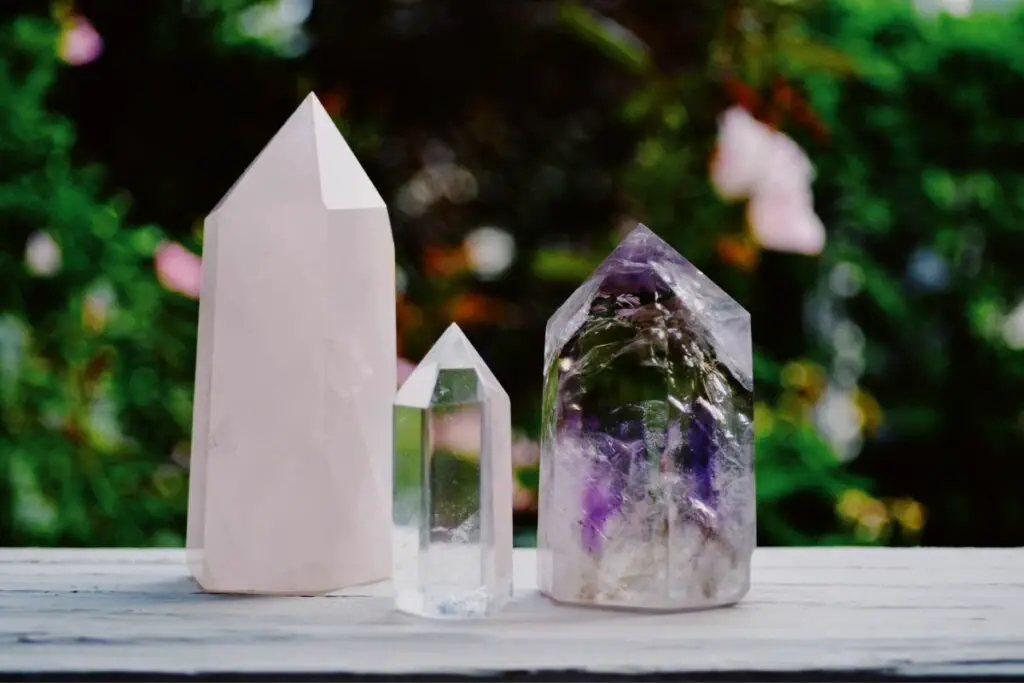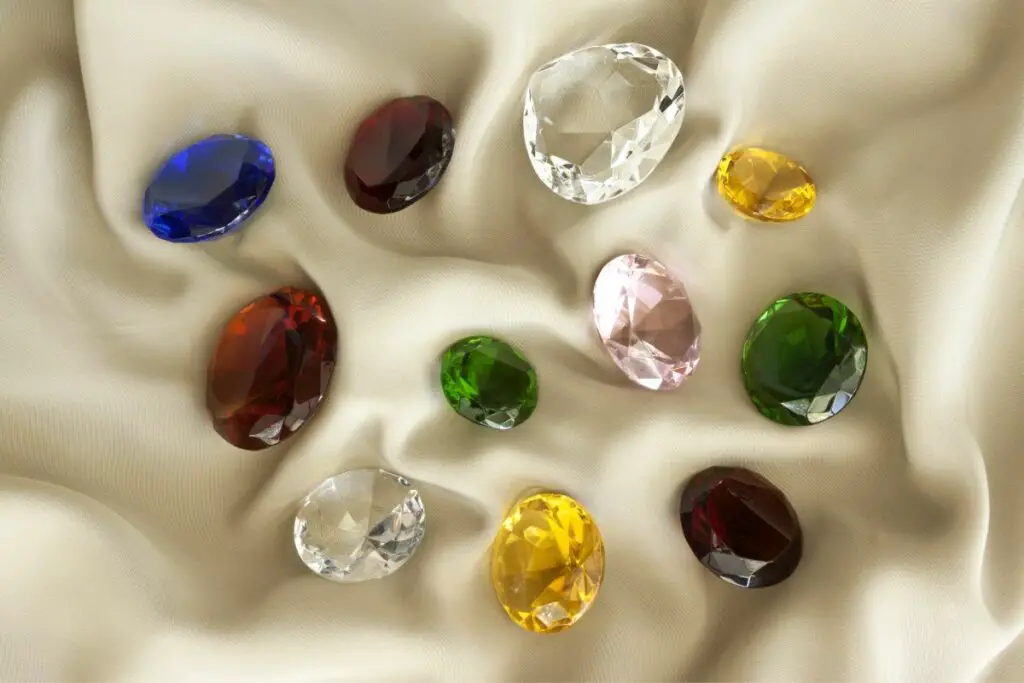Gemstones have been a vital part of human civilisation for thousands of years. Even ancient cultures valued them and used them for various purposes. Of course, this is still true in the modern world.
So, if you’re buying a gemstone as an engagement ring, as an investment, for healing, or for other spiritual practices, you need to know whether it is real or not.

Sadly, as with everything in life, there are many people out there who try to deceive buyers by selling fakes.
In this article, I am going to talk about how to tell if a gemstone is real. I will go over some methods that you can use at your home to check your crystal.
Why Is It Important To Check If A Crystal Is Real?
Well, firstly you don’t want to be ripped off. Some crystals and gemstones can be quite pricey, and the last thing you want is to be ripped off by receiving a fake.
This is particularly prevalent online – so take good care and buy from reputable sellers with good reviews.
But, putting money aside, if you’re buying a stone for healing purposes, you need to know you’re getting the right item and that it is genuine so you can benefit from its healing abilities.
How Can I Test My Gemstone At Home?
There are a number of ways you can test a gemstone at home to see if you’ve received a genuine item:
1) Examine The Surface
The first thing you can do is examine the surface of your gemstone. There are lots of clues that might tell you whether it is real or not.
For example, real gemstones have slight imperfections because of the way they are formed. These can include things like inclusions, blemishes and cracks.
Synthetic gemstones, however, often appear perfect in appearance. This is because they are mostly created under perfect lab conditions.
Of course, if you bought a real gemstone that is highly polished and refined, these imperfections wouldn’t be too noticeable. But for other types of gemstones that aren’t processed too much, you can definitely use this method to test them.
To examine the surface of a crystal, you can use a magnifying glass or look at it carefully with the naked eye. If you happen to have a jeweller’s loupe, that’s even better!
2) Conduct A Hardness Test
To conduct this test, you will first need a Mohs Hardness Test Kit. These days kits like these are easily available online and are quite affordable.
The logic behind this test is that the hardness of gemstones differs from one another. That means, the hardness of a genuine gemstone will also differ in contrast to a fake one.
For example, if you bought an Emerald, it will have a much higher hardness level compared to a fake emerald that is most probably made of glass.
So, how does this method work? Well, before I get to that, you should know that there is a rating system called the Mohs hardness scale that determines the hardness level of every crystal and stone. You can literally look up the hardness rating of every single gemstone in the world.
So, when you get your Mohs hardness test kit, you will find that it contains pins with different hardness levels mentioned on them. Typically, a test kit comes with pins ranging from a hardness rating of 2 to 9.
Next, you can look up the hardness level of the gemstone you bought.
For example, if you bought a Sapphire, its hardness rating is 9. So, you will need to take a pin that has a hardness rating of 8 (one level less) and then try to scratch the surface of your sapphire crystal. If it is real, it won’t get scratched at all. However, if it is a fake, it will scratch.

3) Look For Air Bubbles
This method will work only if you have a gemstone that is transparent or translucent.
The idea here is to see whether your gemstone has air bubbles within it or not. This is because when something is made out of glass, there are chances that air will get trapped within it.
So, if your gemstone is a fake and is made from glass, it might contain tiny air bubbles.
So, how do you conduct this test?
Well, there are a couple of ways that come to mind. First, you can look through it with a magnifying glass or a jeweller’s loupe. If you see a single or a cluster of air bubbles, it means that the gemstone might be fake.
Another way you can conduct this test is by using a glass of water. To do this, you need to fill a clear glass with water and drop your crystal into it. Let the water settle and then examine it closely. If you see any bubbles inside the gemstone, it might be a sign that it is fake.
This method of looking for air bubbles should be used in conjunction with one or more methods mentioned in this article. That is because the results of this test may not be conclusive.
After all, there are certain gemstones that have pockets of air inside them due to their natural formation process.
It’s also worth remembering that if you have a ‘soft’ crystal, according to the Mohs scale, you shouldn’t put it in water as you risk damaging it.
4) Check The Weight
This is an easy test to conduct. You can use a digital scale to check the weight of the gemstone you just bought.
Generally speaking, it is said that synthetic gemstones are denser than real gemstones so, they are heavier.
So, if your gemstone is heavier for its size, it might be a fake.
With that being said, there are many cases where the real gemstone might be heavier than its fake counterpart. So, in cases like these, if your gemstone is lighter for its size, it might be a fake.
Yes, I understand that this might be a little confusing, but if you do a little research online, you can understand what your particular gemstone is supposed to weigh.
5) Test The Colour
This method might require you to do some research about how exactly your gemstone is supposed to look in terms of its colour.
Different gemstones have different colour properties and you can use this to determine whether your gemstone is authentic or not.
This is because synthetic crystals are often created to mimic the colour of natural stones, but they may not have the same depth and complexity of colour.
For example, a genuine Ruby will have a rich, deep red colour that is difficult to replicate in a synthetic stone.
Another thing to look out for is banding and patterns. Malachite is a great example of this. Natural Malachite will have random lines and swirls, whereas a fake Malachite crystal will have a uniform pattern.
To test the colour of your gemstone, you can examine it under different lighting conditions.
Natural gemstones may appear to have different colours in different lighting conditions, while synthetic stones may appear the same under all lighting conditions.
Final Thoughts
Sadly, it’s not uncommon for fake gemstones to be passed off as real so sellers can make a profit.
Whether you’re purchasing a crystal in a piece of jewellery or to use it in your healing practices, it’s important to know you’re receiving a genuine product.
I’ve been caught out a few times with fake gemstones and crystals, so I hope the above tips help you test your own crystals. I promise it becomes easier the more you do it.
- Pegasus Symbolism: Understanding The Spiritual Meaning And Dream Meaning Of Pegasus - November 5, 2023
- 50 Beautiful Moonstone Affirmations To Try - November 5, 2023
- The 6 Best Samhain Crystals To Work With This Spooky Season - October 23, 2023






